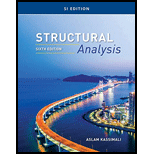
Concept explainers
(a)
Check the given frame is unstable, statically determinate, or statically indeterminate. Find the degree of static indeterminacy in case of the frame is statically indeterminate.
(b)
Check the given frame is unstable, statically determinate, or statically indeterminate. Find the degree of static indeterminacy in case of the frame is statically indeterminate.
(c)
Check the given frame is unstable, statically determinate, or statically indeterminate. Find the degree of static indeterminacy in case of the frame is statically indeterminate.
(d)
Check the given frame is unstable, statically determinate, or statically indeterminate. Find the degree of static indeterminacy in case of the frame is statically indeterminate.
Trending nowThis is a popular solution!

Chapter 5 Solutions
Structural Analysis, Si Edition (mindtap Course List)
- Note: the two questions are connected as parts so please answer soil mechanics question as best you can !. Provide a clear, step-by-step simplified handwritten solution (with no extra explanations) that is entirely produced by hand without any AI help. I require an expert-level answer, and I will assess it based on the quality and accuracy of the work, referring to the attached image for additional guidance. Make sure every detail is carefully verified for correctness before you submit. Thanks!.arrow_forwardQ1) Compute the ultimate bearing capacity using the Vesic method 0.6 m 0.8 m 580 kN 200 kN y=17.29 kN/m³ Ysat 19.3 kN/m³ T 2.0 m 200 kN 150 kN 3.0 m GL ✓ WT 0.6 m c=26 kN/m² =26°arrow_forwardPlease do not use any AI tools to solve this question. I need a fully manual, step-by-step solution with clear explanations, as if it were done by a human tutor. No AI-generated responses, please.arrow_forward
- what is admixture and what are the characteristics of it explain in detailarrow_forwardRobert Moses is one of the most influential—and controversial—figures in American urban planning history. His imprint on New York City and its surrounding regions remains evident in highways, parks, bridges, and housing policies. However, his approach to planning often excluded public input and disproportionately harmed communities of color and low-income populations. This assignment challenges you to reflect critically on Moses’ legacy and draw connections to contemporary urban planning challenges. Reflect on Power and Authority in Planning: How did Robert Moses’ accumulation and use of unelected power shape the urban landscape of New York? What lessons can modern planners learn about checks and balances in urban development? Community Impact Analysis: Identify and discuss at least one community or population that was negatively impacted by Moses' planning decisions. What were the long-term effects on that community? How might a more equitable planning process have changed the…arrow_forwardAfter watching the video "The Rise and Fall of Robert Moses" (Vox), write a 1-page (approximately 500 words) double-spaced response that addresses the following: Reflect on Power and Authority in Planning: How did Robert Moses’ accumulation and use of unelected power shape the urban landscape of New York? What lessons can modern planners learn about checks and balances in urban development? Community Impact Analysis: Identify and discuss at least one community or population that was negatively impacted by Moses' planning decisions. What were the long-term effects on that community? How might a more equitable planning process have changed the outcome? Contemporary Relevance: Can you identify a current or recent urban planning decision (local, national, or international) that echoes the same issues of power, displacement, or inequity? Compare the two and discuss how modern planners might address these concerns differently.arrow_forward
- Please answer the question in the picture and make sure your work is correct please. Thank youarrow_forwardSolve the problem in the picture please only solve the part for the wall load at assuming rigid diaphragm please. Make sure you do the right work and show all of your work please. Thank you!arrow_forwardPlease solve this and make sure you show all of your work, Thank you for your help!arrow_forward
- 15'-0" 15'-0" Architect specifications: 1) Superimposed dead load (including finishes, partition, mep etc) for each floor are shown next page. 2) The facade weight is 200 plf and it's all around the building, the parapet weight at the roofs is 100 plf. Don't forget to add these loads at the perimeter beams. 3) Wind Load is 30 psf 4) Use steel or LVL for beams, TJI of common wood for joists. 5) Submit your calc package by Sunday May 11th ALL STRUCTURAL ITEMS IN RED ARE PART OF THE GRAVITY SYSTEM ALL STRUCTURAL ITEMS IN BLUE ARE PART OF THE LATERAL SYSTEM I 10'-0" 2 10'-0" 10'-0" B I I I LAYOUR FOR OFFICES Things Required Dead and Live Load Schedule Gravity design for office floor - Load calculations (DL + LL + facade load if on perimeter) Beam sizing Joist spacing/type (TJI or LVL) Provide calculations for: Reaction forces Maximum moments Shear • Beam sizes (steel or LVL) Key Map of elements (your office layout plan with beam/joist marks) Iarrow_forwardplease solve the problem in the picture make sure you show all of your work, thank you so much for your help!arrow_forwardPlease solve the question in the picture make sure you show all of your work and show every step you do please. Thank you so much for your help!arrow_forward
